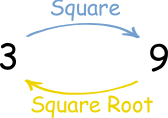As a math student, you probably learned the squares of each number from one to 12 when you were young. For instance, you know that 7 times 7 is 49. Hence, the square root of 49 is obviously 7. But what happens when you are faced with a question like how to find the square root of 12?
You can get to the answer faster than you might have thought by using deductive reasoning and common place formulas.
How to Find Square Root of 12 Step One: Guesstimate Your Answer
Common sense tells you that 12 falls between two other squares, 9 and 16. Nine is the square of 3 and 16 is the square of four. Consequently, you already know that your answer is going to be more than 3 and less than 4.
This knowledge is a practical way to keep your final answer in check. For instance, if you try to find the square root of 12 and end up with a number that begins with 6, you will instantly realize you made an error.
How to Find Square Root of 12 Step Two: Break up the 12
The square root of 12 can be broken into two components because when two square roots are multiplied, the multiplication rules are the same as if they were not square roots. Consequently, the square root of 4 multiplied by the square root of 3 equals the square root of 12. Since you already know that the square root of 4 is 2, you can simplify your problem to 2 multiplied by the square root of 3.
Now, you only have to find the square root of 3 and multiply it by 2, which seems simpler and less wieldy than finding the square root of 12.
How to Find Square Root of 12 Step Three: Use Some Trial and Error
Although there is an algorithmic formula for finding square roots, you can also play around using old-fashioned trial and error. In fact, this is helpful when you are just beginning to encounter square roots because it helps you gain perspective on these fascinating numbers.
For example, you know that the square root of 3 is going to be a number between 1 and 2 multiplied by itself. Therefore, you can start at the midpoint of 1.5. Squared, 1.5 equals 2.25, not quite enough to reach 3. Thus, you know you should go higher. How about 1.7?Squared, 1.7 equals 2.89. That’s much closer to 3.
You can then try to square 1.8, which gives 3.24, more than the prime number 3 you are seeking.
In moments, you have determined that the square root of 3 begins with 1.7. You could add further decimal places if desired, or can stick with 1.7. For a quick shortcut, it could help to speak with an online math tutor for tips on how to use square root calculators.
How to Find Square Root of 12 Step Four: Finalize Your Answer
For the sake of ease, let’s go with 1.7 as the square root of 3.
Multiply 2 (which was the square root of 4) by 1.7 (our estimated square root of 3) to get 3.4. Then, check the answer by squaring 3.4. You get 11.56, very near to 12. If you want to get nearer, you can quickly add decimal places, changing the estimate to 3.41 (which squares to 11.6), 3.42 (which squares to 11.7), and so on.
How to Find Square Root of 12 Step Five: Getting to the Square Root of 12 or Another Tricky Number
 As you can see, it is possible to break down just about any square root of a non-prime through a little math know-how. Test yourself by trying to determine the square root of 20 or 28 for practice. This exercise will prove especially helpful once you begin solving for the quadratic formula.
As you can see, it is possible to break down just about any square root of a non-prime through a little math know-how. Test yourself by trying to determine the square root of 20 or 28 for practice. This exercise will prove especially helpful once you begin solving for the quadratic formula.
Eventually, you can do fast evaluations of all square roots without the need for help, which is a great feeling when you are on your own and facing a test or homework assignment.


